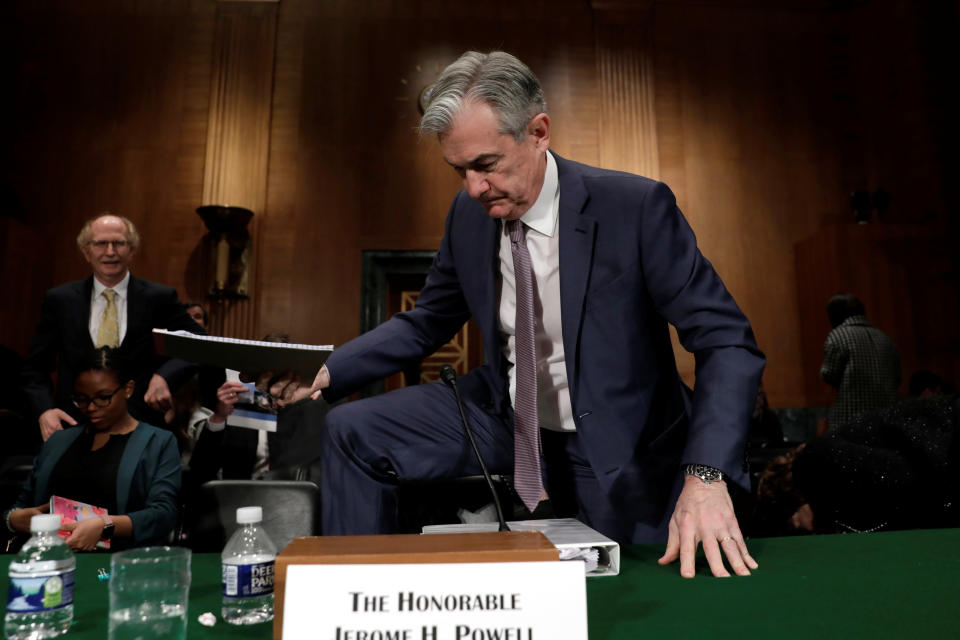Fed announces over $1 trillion liquidity operation as bond market churns
The Federal Reserve has launched an over $1 trillion liquidity operation to support money markets amid the new coronavirus outbreak, and is now one step closer to resuming its crisis-era policy of purchasing assets in a process called quantitative easing.
The liquidity is being offered through temporary repurchase agreement operations based out of the Federal Reserve Bank of New York.
The repo market provides financing for banks and broker-dealers at the center of the economy, allowing the levered institutions to cover positions on their balance sheet by lending sums of cash to one another.
Amid market volatility stemming from the new coronavirus and an oil price shock, the market for U.S. Treasuries showed signs of cracking.
In a normal risk-off dynamic, yields on U.S. government debt tend to fall as the stock market falls. But in recent days, Treasury yields have risen despite extended sell-offs in equities, signaling concerns that liquidity was drying up in a critical corner of finance largely seen as among the more liquid markets.
On Thursday afternoon, the New York Fed announced that it would expand the scope of its repurchase agreement market operations to offer $500 billion in three-month operations, another $500 billion in one-month operations, and at least $220 billion in operations with durations of two weeks or fewer.

“These changes are being made to address highly unusual disruptions in Treasury financing markets associated with the coronavirus outbreak,” the New York Fed said in a statement.
Notably, the Fed also announced that it was changing its plan on asset purchases to include a “range of maturities” of Treasuries. Prior to the announcement, the Fed had been buying $60 billion a month of short-term T-bills. The New York Fed now says it will buy “coupons” that would have comparatively longer maturity.
Wall Street analysts now say the Fed is likely to announce a full QE4, a fourth version of quantitative easing, which may also include agency mortgage-backed securities, in its meeting next Wednesday.
BofA wrote Thursday morning that the Fed needed to step in to support the Treasury market, which had volatility levels comparable to the European Union breakup concerns in 2011 and the financial crisis in 2008.
Evercore ISI wrote Wednesday that the Fed needs to “aggressively” expand its asset purchases.
“This is overdue,” Evercore’s Krishna Guha and Ernie Tedeschi wrote. “It should now be imminent.” They added that the funding pressures increase the likelihood that the Fed would get back to zero interest rates soon.
BofA, Barclays, and Morgan Stanley are now among the Wall Street firms with research teams predicting resumption of QE in the Fed’s next meeting on March 17 and 18.
Pinpointing the problem
Analysts are scratching their heads trying to figure out why counter-parties are sidelining themselves from the Treasury market. In any event, dealers appear to be shifting their focus away from the U.S. Treasury market in favor of deploying their balance sheets somewhere else.
In the face of financial turmoil, banks and broker-dealers may be choosing to preserve their own funding as opposed to do market-making. Goldman Sachs CFO Stephen Scherr said Tuesday that his firm is comfortable providing liquidity but did not deny that firms are pulling back.
“It is far from broken, but we've seen liquidity dry up in a lot of markets. Price action [is] reflective of it,” Scherr said. “In certain markets and in certain geographies, you've seen people withdraw from the provision of liquidity in the context of risk and otherwise.”
Guha and Tedeschi added that the coronavirus itself could exacerbate the issue, as employees at dealers and banks are forced to work from home. They pointed out that a lot of the market movements are done in the morning, warning that slower activity as a result of teleworking set-ups may worsen “inefficiencies and diminished market functioning.”
What can the Fed do?
Since last September’s flare-up in money markets, the Fed has relied on its own repo operations to provide liquidity to banks and broker-dealers.
The actions could provide dealers with funding to confidently support trading in the U.S. Treasury market. But when the New York Fed opened its doors to term repos on Thursday morning, dealers flooded the repo facilities with more submitted bids than the repo operation could accept.
That suggests that the Fed may want to expand the size of its term repos or offer repos of longer duration sometime soon. Hours later the Fed announced the over $1 trillion repo operation.
Calls are increasing for the Fed to step in as its own counter-party through a fourth round of quantitative easing. Already, the Fed is buying short-term T-bills at a pace of $60-billion-per-month, but the Thursday announcement that it was shifting the target duration of its asset purchases hints at more flexibility in its balance sheet policy.
“We think the Fed will announce a QE program that targets buying $75 billion a month of Treasuries, focused on the back-end,” Morgan Stanley’s research team wrote Thursday.
Barclays wrote Thursday that it expects the Fed to buy $55 billion of agency mortgage-backed securities each month “to rein in credit and equities too.”
The Fed’s next policy-setting announcement, where the expectation is to lower rates further, is scheduled for March 18.
Brian Cheung is a reporter covering the Fed, economics, and banking for Yahoo Finance. You can follow him on Twitter @bcheungz.
Energy-exposed banks attempt to bounce back after second punch from oil prices
Fed's move to tap liquidity operations will 'buy time' on more rate cuts: Barclays
'Talk ourselves into a recession': Bank in coronavirus hotspot has doubts over Fed rate cut
Boston Fed President: Quantitative easing may not work as well next time
'We are all competing': Los Angeles finds new ways to tackle labor shortage
Read the latest financial and business news from Yahoo Finance
Follow Yahoo Finance on Twitter, Facebook, Instagram, Flipboard, SmartNews, LinkedIn, YouTube, and reddit.
